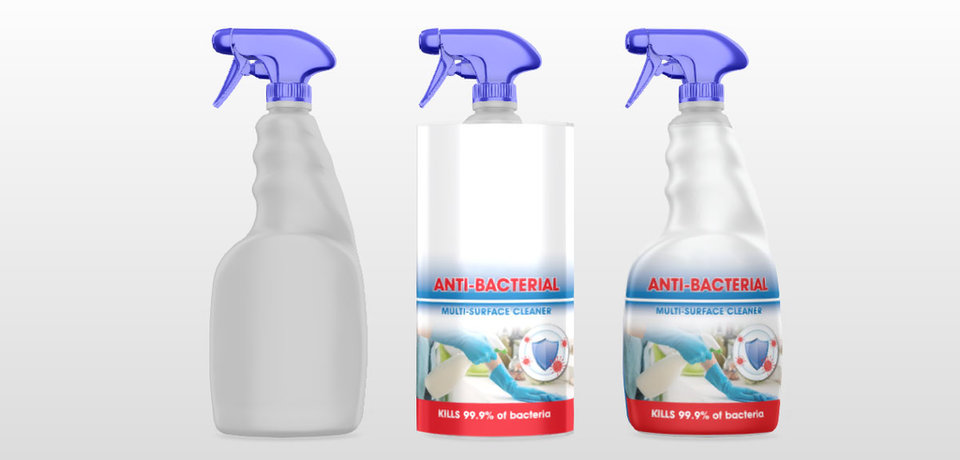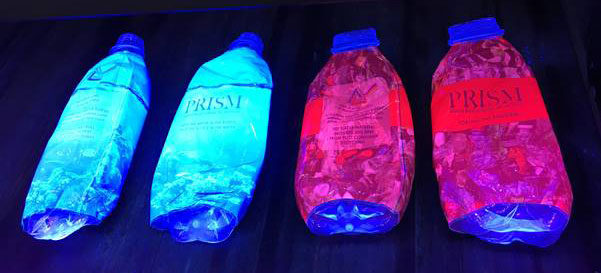labelling | recycling
labelling | recycling
Grey is the new black for sustainable packaging
As companies struggle to strike the balance between using responsible materials and ensuring that their branding remains intact, Professor Edward Kosior, managing director at Nextek, argues that Ultraviolet markers in labelling could be the solution.
Cover image: Shutterstock
Single-use
plastic packaging has had its day. Organisations around the world are now increasingly focusing on optimising the extension of global plastic packaging production and the all important after-use value chain.
Not everyone is on the same page, however. It is interesting to see that whilst in Japan there are no coloured PET bottles by unanimous industry agreement and recycling targets are easier to reach, other countries around the world struggle with their attachment to coloured PET bottles. The same recycling constraints can be seen in other forms of coloured HDPE and PP packaging.
There is no doubt that if we are to achieve systemic change to overcome stalemates in today’s plastics economy, brand owners need to take additional transformational steps when it comes to their packaging brand design.
If we can’t eliminate coloured bottles then we need to re-address the issue by separating the main colours, such as natural plastics and white plastics. This is achievable, although it does mean that the bulk of the remaining materials are composed of various colours that create a new “self-coloured grey” once blended and extruded to granules.
Self-coloured grey may not, at first sight, appeal to brand owners, keen to maintain their original brand design cues, which leads us to seek other solutions if sustainability goals are to be reached.
The solution? Plastic shrink sleeves
It is true: shrink sleeves have been around for decades. In fact the first ones appeared in 1960 in Japan, where Fujio Carpentry Shop invented them to provide a new form of tamper-evidence following the change by Sake from wooden barrels to glass bottles.
Brand owners embraced the shrink sleeve’s 360 degree design capability only to find there were some serious challenges with cradle-to-cradle recovery, such as difficulties removing the labels, the blinding of auto-sort devices through to melt and bleed issues.

Shrink sleeves allow branding flexibility, no matter the colour of plastic
Today’s new shrink sleeves are vastly improved versions of their earlier counterparts. Now they have double perforations that are easily identifiable and removable by consumers.
The use of shrink sleeves could go a long way towards increasing recycled content and also save on masterbatch costs. It would also preserve the original brand and design identity of the bottle to ensure consumer recall.
In fact, all of the initial design benefits brand managers enjoyed when they first started using plastic sleeves are still present, and any visible part of the bottle would communicate to consumers that recycled plastics are being used, something that will be seen as a positive for the brand owners.
Improved recycling processes now enable both sorting and recycling with the sleeves in place. This is the case for PET sleeves on PET bottles although the recognition of PET sleeves on HDPE bottles might seem more challenging.
Self-coloured grey is set to represent the new normal colour of sustainable packaging
Sorting solutions for sleeves in recycling
Some recyclers already use bottle de-labelling machinery that remove labels and external contaminants so that bare bottles go to the automatic Near InfraRed spectroscopy (NIR) sorters.
Sorting equipment is now capable of detecting both the sleeve and the underlying polymer if the sleeve is thin, for example 50 microns. This would allow the classification of the bottles into the designated categories for recycling.
Of course being able to identify the bottle under the sleeve and therefore guide it to the correct recycling stream would offer brand owners the added assurance that their packaging would be properly recycled without relying on consumer input.
This is where markers, such as the PRISM fluorescent markers developed by a consortium led by recycling specialist Nextek, come into play, ensuring sleeved bottles are properly identified during sorting.

PRISM labels in practice
The process is surprisingly simple. Fluorescent markers are printed on labels or plastic packaging sleeves. As the mixed plastic waste runs along the conveyor belt, the high-speed sorting system is illuminated by an ultraviolet (UV) light source that identifies the coded PRISM label, and reads its code before air-jets propel it into the appropriate recycling category.
Until now the NIR techniques used to identify different polymers were unable to detect dark-coloured plastics as they absorb the radiation. PRISM not only allows recyclers to efficiently tag full-length shrink-sleeves, it can also distinguish between food-grade and non food-grade polymers.
Following extensive trials, PRISM is now well proven in Materials Recovery Facility (MRF) setups and is plug & play ready. It is complementary to existing NIR technology and can easily be adapted to most sorting facilities around the world to target specific recycling streams such as food contact plastic packaging. This innovative technology uses traditional labelling and branding methods that can be coded to specify the status of the pack.
Grey is the new black, but sleeves will keep brands consistent
This kind of technology spells out a new potential future for sleeved bottles as it allows brand owners to maintain their strong design appeal whilst increasing recycling potential.
In the current environment where there is “no away'', and producer responsibility needs to come to the forefront, self-coloured grey is set to represent the new normal colour of sustainable packaging that has been constantly recycled.
The opportunities for innovation via sleeves and labels is vast and could help both brand owners and consumers to meet their targets and expectations for recycled content.
Making it technically possible for all of our plastic packaging to be reused or recycled will go a long way towards boosting the plastic recycling sector and establishing a stronger circular economy.
Cover image: Shutterstock